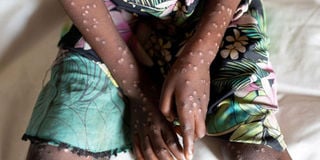More men get Mpox through sex, WHO reports

A person presenting with signs and symptoms of Mpox disease. PHOTO | FILE
What you need to know:
- Mpox can also be transmitted through contaminated items like bedding, clothing, eating utensils, and sex toys.
Nine out of every 10 Mpox cases reported are men with most of the infection transmitted sexually.
According to the World Health Organisation report, 87,189 out of 90,410 cases were men, 96 percent of whom got infected through sexual intercourse. It also indicated that the virus was reported in men aged between 29 and 41.
The multi-country outbreak report assembled case-based data from national authorities as of June 30, 2024.
The report, released yesterday, also states that globally, sexual contact is the most commonly reported mode of transmission (19, 102 of 22,801 cases) followed by person-to-person non-sexual contact.
“This pattern has persisted over the last six months, with 97 percent of new cases reporting sexual contact. Among cases where at least one symptom is reported, genital rash was the most common symptom followed by fever and systemic rash,” says the report.
It adds: “Sexual transmission has been recorded in the Democratic Republic of Congo among sex workers and men who have sex with men. Among cases exposed through sexual contact in the Democratic Republic of the Congo, some individuals present only with genital lesions, rather than the more typical extensive rash associated with the virus.”
The international health agency reported that sexual transmission of Mpox happened through oral and penetrative vaginal or anal sex with someone infectious. People who have sex with multiple or new partners are most at risk.
“Anyone with new and unusual rashes should avoid having sex or any other kind of close contact with other people until they have been tested for sexually transmitted infections (STIs) and Mpox. Remember that the rash can also be found in places that can be hard to see inside the body, including, the genitals area.”
WHO recommends methods of reducing the risk of sexual infection by openly communicating with partners about Mpox symptoms and risks, informing sexual partners of any symptoms developed, taking a break from having sex, and reducing the number of new sexual partners, one-off sexual partners.
It also recommends consistent use of condoms, avoiding group sex, avoiding sex-on-premises venues such as cruising bars, saunas and darkrooms, and avoiding using alcohol or drugs in sexual contexts.
“While Mpox virus has been found in semen, it is currently not known whether it can be spread through semen or vaginal fluids.
“Wearing a condom won’t fully protect you from Mpox, but it may reduce your risk or extent of exposure and it will help protect you and others from HIV and a range of other STIs. People with Mpox are advised to use condoms for 12 weeks after they recover,” says WHO.
Mpox is a viral zoonotic disease mainly found in the tropical rainforest regions of Central and West Africa. Symptoms include a skin rash, fever, sore throat, headache, body aches, back pain, low energy, and swollen lymph nodes. The virus spreads primarily through close person-to-person contact, particularly skin-to-skin contact, exposure to contaminated materials, and sexual contact.
Those at higher risk of contracting Mpox include close contacts of infected individuals, healthcare workers, people who handle wild animals, laboratory workers, children, and pregnant women, immunocompromised individuals, and people with multiple sexual partners.
Mpox can also be transmitted through contaminated items like bedding, clothing, eating utensils, and sex toys.
Mpox cases have been confirmed in Burundi, Kenya, Rwanda, and Uganda in Eastern Africa, where the disease has emerged for the first time.
However, it is endemic in Benin, Cameroon, the Central African Republic, the Democratic Republic of Congo, Gabon, Ghana, Ivory Coast, Liberia, Nigeria, Sierra Leone, and South Sudan. Globally, Africa reported the highest number of cases in June, with 567 infections, followed by the Americas (175 cases), Europe (excluding the Eastern Mediterranean region) with 100 cases, the Western Pacific with 81 cases, and Southeast Asia with 11 cases.
Between January 1, 2022, and June 30, 2024, a total of 99,176 laboratory-confirmed cases of Mpox, including 208 deaths, were reported from 116 countries across all WHO regions.
*Written by Mercy Chelangat




